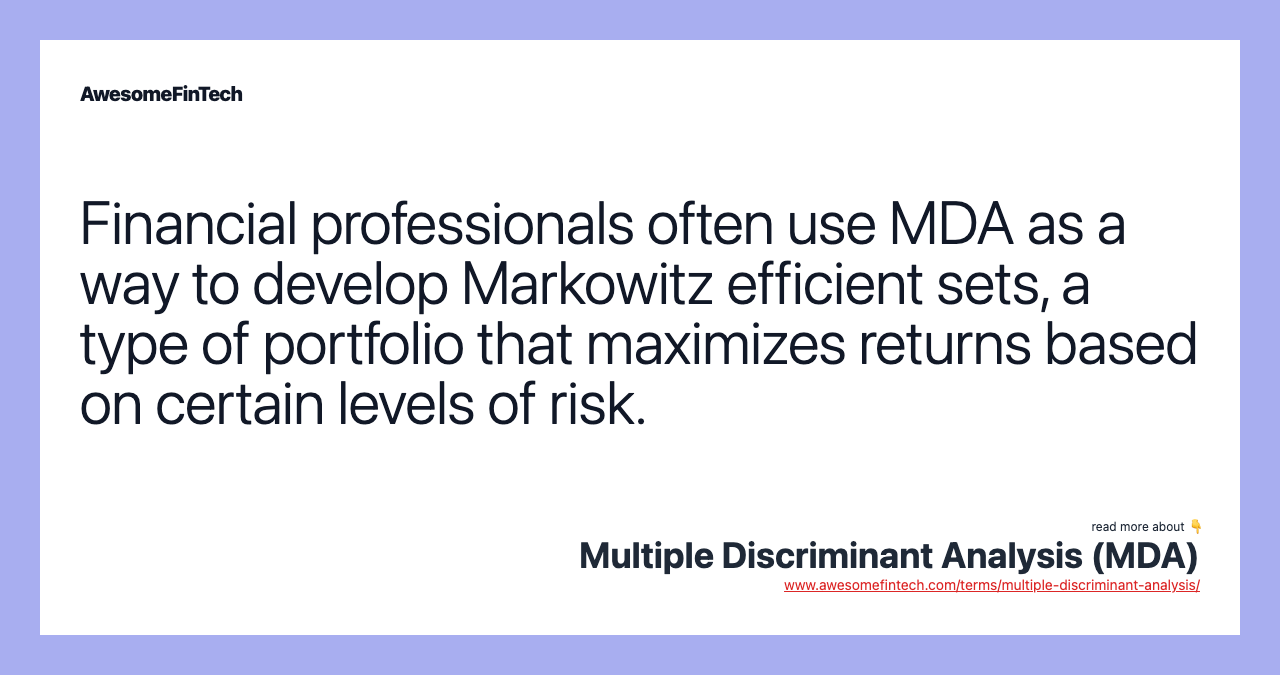Multiple Discriminant Analysis (MDA)
The term multiple discriminant analysis (MDA) refers to a statistical technique used by financial planners, investment advisors, and analysts to evaluate potential investments when many variables are at stake. As noted above, multiple discriminant analysis is related to discriminant analysis, which is commonly used by statisticians and other researchers. This is a branch of discriminant analysis, which is used by researchers and statisticians who make classifications of individuals and data based on different variables. An analyst who is considering a number of stocks may use multiple discriminant analysis to focus on the data points that are most important to the decision in question.

What Is Multiple Discriminant Analysis (MDA)?
The term multiple discriminant analysis (MDA) refers to a statistical technique used by financial planners, investment advisors, and analysts to evaluate potential investments when many variables are at stake. MDA allows financial professionals the viability of investing in various market securities by studying different factors or variables, such as volatility. This is a branch of discriminant analysis, which is used by researchers and statisticians who make classifications of individuals and data based on different variables.





Understanding Multiple Discriminant Analysis (MDA)
Multiple discriminant analysis is a technique that distinguishes datasets from each other based on the characteristics observed by a professional. It is used in finance to compress the variance between securities while screening for several variables.
By using the MDA technique, financial professionals reduce the differences between certain variables so they can be classified into a number of larger groups and then compared to another variable. In most cases, professionals who use MDA often try to group data into at least three, if not more, different groups.
An analyst who is considering a number of stocks may use multiple discriminant analysis as a tool to focus on the data points that are the most important. This simplifies the other differences among the stocks without totally dismissing them. For instance, an analyst who wants to select securities based on values that measure volatility and historical consistency may use MDA in order to factor out other variables such as price.
Other variables that analysts can use when employing multiple discriminant analyses include different financial ratios.
The main reason that professionals use this technique is to develop Markowitz efficient sets. These investment portfolios are developed based on returns that are maximized for a certain level of risk. These were named after economist Harry Markowitz, who is also considered to be the father of modern portfolio theory (MPT).
Special Considerations
As noted above, multiple discriminant analysis is related to discriminant analysis, which is commonly used by statisticians and other researchers. MDA is also known, at least to statisticians, as canonical variates analysis or canonical discriminant analysis.
It is a type of discriminant analysis, which is widely used by researchers analyzing data in many fields. Discriminant analysis helps researchers and statisticians classify different data sets by setting a rule or selecting a value that will provide the most meaningful separation.
Related terms:
Data Analytics
Data analytics is the science of analyzing raw data in order to make conclusions about that information. read more
Finance
Finance is the study and management of money, investments, and other financial instruments. Learn about the basics of public, corporate, and personal finance. read more
Financial Planner
A financial planner is a qualified money-management professional who helps clients meet their financial goals. read more
Homogeneous Expectations
Homogeneous expectations is a modern portfolio theory that assumes all investors expect the same and make identical choices in a given situation. read more
Investment Advisor
An investment advisor is any person or group that makes investment recommendations or conducts securities analysis in return for a fee. read more
Markowitz Efficient Set
The Markowitz efficient set is a portfolio with returns that are maximized for a given level of risk based on mean-variance portfolio construction. read more
Modern Portfolio Theory (MPT)
The modern portfolio theory (MPT) looks at how risk-averse investors can build portfolios to maximize expected return based on a given level of risk. read more
Portfolio
A portfolio is a collection of financial investments like stocks, bonds, commodities, cash, and cash equivalents, including mutual funds and ETFs. read more
Predictive Analytics
Predictive analytics is the use of statistics and modeling techniques to determine future performance based on current and historical data. read more
Statistics
Statistics is the collection, description, analysis, and inference of conclusions from quantitative data. read more